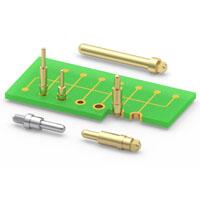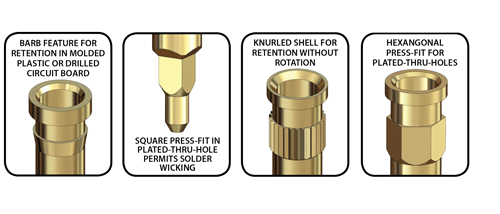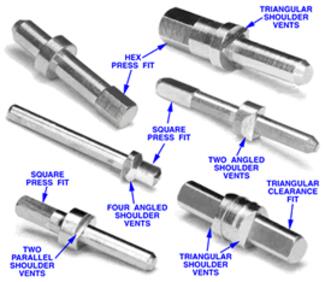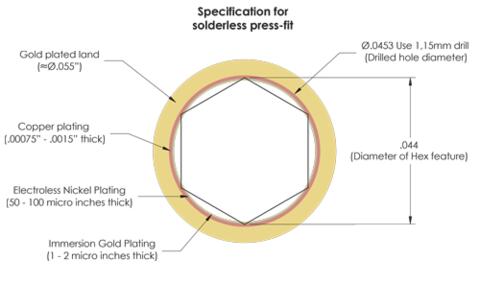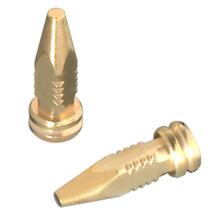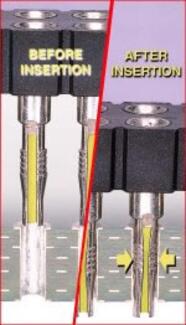Mill-Max Press-Fit Pins
Introduction to Press-Fit Technology
Mill-Max press-fit-style pins and receptacles are among the most versatile types of interconnection components for electrical and electronic applications. Used individually or assembled in connector arrays, they can be useful to terminate a single wire to a PC board or as a board to board or board to component interconnect. Individual pins and receptacles are available in sizes suited to particular form factors and may be used for the transmission of signals from power on down to logic level. Applications can be in power, control functions, signal, data, even RF.
Benefits of Press-fit Pins and Receptacles
The Mill-Max approach to press-fit pins and receptacles is unique, applying specialized precision-machined pin technology, offering multiple advantages over stamped-and-formed connectors:
- Seamless construction prevents contact contamination from wave or reflow soldering.
- Specialized press-fit feature geometries (triangle, square, hexagon, octagon) to meet the hole size requirements of specific applications.
- Lead-in countersinks on pin receptacles to facilitate pin alignment.
- Pin and receptacle shells are machined from brass alloy, for strength, conductive and thermal properties.
- Multi-finger beryllium copper contact clip scores the mating device lead for gas-tight electrical connection and provides best power and force distribution.
- Two-piece receptacle construction (shell and contact clip) allows for cost-efficient plating combinations for best solderability and conductivity
Options for Machined Pin Technology
Mill-Max's precision machining technology allows us to cut multiple shape features, such as a knurl or barb for insertion into non plated through holes or plastic insulators. For plated through holes we recommend a hex or square, along the pin barrel or a unique compliant feature on the tail.
Options for Plated Through Holes (PTH)
For applications requiring a press-fit into plated through holes on multi-layer circuit boards Mill-Max recommends multi-faceted or compliant pin designs. The multi-faceted press-fit shape will leave a contiguous path of copper from the bottom of the hole to the top of the hole after press-fitting. The points along the diameter of the press-fit shape are intended to cut into the copper wall of the plated through hole while the flats of the shape provide relief to minimize the risk of creating voids in the plated through holes. Hole sizes for multi-faceted press-fit pins require more consideration than a standard plated through hole; particular attention must be paid to the drill size used. The drill size should be slightly larger than the diameter of the points of the press-fit feature. For example: if a discrete receptacle has a hexagonal across points diameter of .109". The hole prior to plating through should be Ø .1095", i.e.: use a #35 or 2,8mm drill. (Actual hole diameters are usually .0005" smaller than the nominal drill size in FR-4). The nominal finished hole size with copper would then be Ø .106".
Repointed drills are not recommended for "press-fit" PTHs. Often the sharp points of the geometric feature are given a .002" flat so as not to cut the copper of the PTH when inserted. When the pin is pressed into the plated-through-hole, it is important for a gap to remain and permit solder to fill the hole and "wick" through the board without voids or flux entrapment.
When pressing gold plated pins into gold plated boards or tin pins into tinned boards, there is "cold welding" of the similar metals in contact. This gives rise to extremely high insertion forces that could damage the board or the connector. A lubricant in the holes will dramatically reduce "cold welding". A contact lubricant such as OS-138 is recommended. A soap solution can also be used followed by a board wash. Alcohol is not as effective a lubricant, but it can be used without leaving a sticky residue. Even with lubricant, some "cold welding" still occurs, and this generates localized heat in the holes during pressing. The press rate should be slow to minimize heat damage to the board.
When specifying plated-through-holes that will receive multi-faceted press-fit pins, the PCB fabricator should be given the actual drill size (prior to plating through) to use as well as a commercial finished hole tolerance (±.002", ±.003" etc.).
A note to board fabricators when plating large panels: it is important to mask the edges of the panel in the electro-copper tank to reduce the excessive build-up of copper in the edge holes relative to holes in the center of the panel. The thickness of the tin-plating in the holes is not critical to the press-fit operation; it is soft enough to be displaced by the pins.
Press-Fit Options for molded housings, or drilled holes (NPTH)
For insertion into molded housings or drilled holes Mill-Max recommends using a on the body of the pin. If rotation is a concern in the application we highly recommend using a on the body of the pin. For these features drilled holes can generally be specified with a ±.001" tolerance.
Also available is our unique, low-profile, compliant body socket receptacle, capable of press-fitting into .041" to .044" diameter FR-4 mounting holes.
Featuring the Mill-Max #10 or #11 contact clip, rated at 2 and 3 amps respectively, this new discrete receptacle is ideal for socketing devices with miniature .010"-.020"(0,3mm - 0,51mm) component leads. The sleek bullet-shaped body self-centers the receptacle into mounting holes. The receptacle shell features a wide-mouth countersink entry for guiding delicate devices leads inside. Precision machined on high-speed screw machines, this brass receptacle is entirely gold plated for optimal conductivity and highest quality.
Mill-Max compliant body receptacles are available in bulk, or custom configured on hi-temperature Kapton Polyimide film for packaging optimization.
- Compliant press-fit body for .041-.044 mounting holes in FR-4
- Discrete socket for miniature device leads between .010" - .020" in diameter.
- Sleek bullet-shaped body for easy board assembly.
- Wide-mouth countersink opening to guide device pin into the receptacle.
- Available in bulk or can be packaged on Kapton film.
- RoHs compliant, Gold plated shell and inner MM#10 or #11 contact clip.
Compliant Tail Press-Fit Options
Our unique compliant pin design is characterized by a hollow and slotted tail that closes down and conforms to the size of the plated-through-hole thus preventing damage. The mechanical and electrical interfaces between the product and PCB are made by a spring-like-compliant section and a plated through-hole. In addition, the combination of slotted tail and a series of fine serrations make a reliable gas-tight connection with the tin plating inside the hole. Mill-Max compliant tail connectors are available as discrete pins and receptacles, in dual-in-line (DIP) packages from 6 to 40 pins, as well as single and double row strips.
Compliant tail sockets are often used for stacking multi-layer boards with a variety of pin headers with either a compliant tail or a standard soldertail.
Compliant tail sockets and interconnects are available in two tail lengths, one for .060" - .100" thick panels, and another for .090"-.130" thick panels.and will work with industry standard hole tolerances of ±.003". The drill size should be specified before plating in order to center the finished hole size within the ±.003" tolerance. For example, to achieve a finished hole diameter of .040±.003", if the copper in the hole is specified as .001" minimum to .0025" maximum, plating would nominally reduce the hole diameter by .0035", hence a 1,1mm (.0433") drill should be used.
Start your search using our product finder now, or contact a Mill-Max Applications Engineer today and let us show you how our precision high-speed turning technology can address your press-fit interconnect requirements reliably, economically and efficiently.

